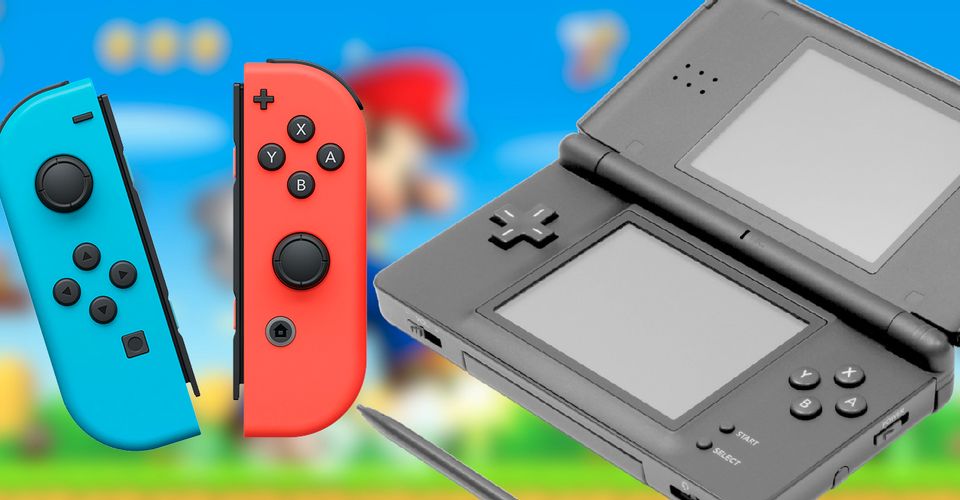Nintendo’s Next Switch Model Could Be A Foldable Switch DS

It’s possible a new Nintendo Switch could have a foldable design like the Nintendo DS. With the rise of foldable book-like tablets like the Microsoft Surface Duo and the return of flip-phones now with a single screen, it’s hard not to look back at the 2000s and compare these new devices to the technology people had back then. However, when looking at the clamshell designs these phones are going back to, the hardware that best shows the possibilities of foldable technology is actually a Nintendo product – the original DS Lite.
The DS and DSi were by all accounts a large success for Nintendo, selling over 154 million units and having a great lineup of games and applications renowned by casual and hardcore fans alike. Everything from the build of the DS Lite to the preciseness of the touch screen gave the system a professional and modern feel despite having an out-there gimmick. The heyday of the DS may have come and gone, but that doesn’t mean that its legacy has been forgotten. Many people view Nintendo as the best handheld game console manufacturer due to the DS’ success. In fact, a new 4K Switch model compatible with the OLED dock could follow in its footsteps and become like the Surface Duo – having two screens.
If its track record of wild game console concepts is anything to go by, Nintendo loves to innovate. A Switch DS would be a risk, but one that would open many possibilities for game and console design. While this idea would be similar to the Wii U, the original Switch learned a lot from its failure and could finally pay off the system’s promise while integrating modern technology with 1080p or 4K resolutions. Whether or not Nintendo keeps the Switch branding, the next console could (and more importantly, should) use detachable dual screens.
A New Nintendo Switch Control Scheme With Two Screens Leads To Great Game Design

On top of displaying more information, the Nintendo DS and its hidden gems proved that two screens could be used to separate play areas and expand gameplay possibilities. Games like Brain Age, Drawn To Life, Pokémon Ranger, and Cooking Mama were all enhanced by the dichotomy of a screen where the action would unfold and one that the player would interact with directly. Even managing inventories in games like Animal Crossing: Wild World and Phoenix Wright were fun, and for games that have no use for the bottom screen, there was no need to use it. Assuming the power of the new Nintendo Switch is comparable or better than the current model, triple-A developers more focused on cross-platform play could still design games for the top screen without using the bottom one.
Currently, touchscreen controls are integrated into the Nintendo Switch with an official stylus in the United Kingdom, but there are few games that take full advantage of it. For those who have tried to build levels in Super Mario Maker 2 or tried to fiddle with the Pokétch in Brilliant Diamond, the problem with the single-screen model becomes apparent quickly. In docked mode, these systems become slow as players must move their cursor with the D-pad and the control stick. Even with touch controls, there’s lots of swapping between menus, and most games that want to have touch elements have to program a system that works the same with a traditional controller. Using both in tandem can lead to quicker responses and a better sense of control, creating unique gameplay experiences that can’t be achieved with just controllers or tablets.
A Design Housing Joy-Cons & A Stylus Would Improve The Nintendo Switch

Unless someone’s using the accessory which doubles the Switch’s size, the Nintendo Switch is already mostly portable. Still, a closing book-like design could do wonders for the system’s longevity without having to lug around a carrying case. Joy-Con drift is only exacerbated by jostling the system in a backpack or handbag and the screen attracts dust rather quickly. Designing beveled screens that can also hold a conductive stylus could stop the screens and Joy-Cons from getting damaged while maintaining a classic DS look.
For TV mode, the bottom screen could detach and be used as a smaller controller for more serious games. Much like the Wii U, the much under-utilized Nintendo Joy-Cons could also be detached from the bottom screen to function more like Wii remotes as their own separate controllers. Modularity with Joy-Cons is what already makes the Switch unique so giving players and developers even more control options could only help.
A New Nintendo Switch Should Learn From The Wii U’s Mistakes

It’s hard to deny that at this point, it sounds like a dual-screen Switch could follow in the steps of one of Nintendo’s greatest missteps, the Wii U. The Wii U failed for a few reasons, and many of those were related to marketing and form factor. One of the biggest disappointments of the era was that there weren’t a lot of solid single-player experiences that took full use of the touchscreen, unlike the now offline-only Super Mario Maker. In the eyes of many Nintendo fans, consumers, and game developers, Nintendo failed to justify why the second screen was worth the lackluster hardware – even when the dual-screen model had proven itself with the Nintendo DS in the previous generation.
Nintendo made sure the Switch had different branding from the Wii era and produced a system that was much sleeker and less toy-looking, yet still had personality with its Joy-Cons and portable nature. A dual-screen Switch, especially one that looked high-class with a matte finish on the outside, could fit right in with tablets and 2-in-1 laptops while still maintaining the colorful designs of the Joy-Cons to set the system apart.
A Nintendo Switch DS Could Salvage The Wii U’s Lost Potential

The Wii U’s library was poised to be a successor to the best-selling Wii and DS games, which was an admirable goal, but it didn’t have third-party support and suffered due to its design and hardware limitations. Creating a home console could provide traditional gaming experiences while also having unique options for designers that want to think outside the box. This could draw lots of attention to a Switch model that has fewer corners cut in the specification department.
One of the greatest hurdles to overcome with a dual-screen Switch revision would be multiplayer. While Nintendo was great at integrating asymmetrical multiplayer into Wii U games, not many developers knew how to create single-player experiences that benefited from the touchscreen on top of a multiplayer experience that couldn’t use it. However, with Joy-Cons, touchscreens, TV and Handheld mode, and Nintendo 64 controller support to work with, there are more than enough combinations to now design different control methods for single-player and multiplayer in the same game.
Play experiences on tablets will most likely not take advantage of the dual-screen format and many will continue to try and fit one screen on a foldable phone. These devices were more meant for reading and writing, and although their designs are interesting, they lack the analog input needed for hardcore gaming. Nintendo is in the business these days of creating dedicated handheld systems, so a Switch DS would probably be the best way to improve on a trend while creating something unique that has already proven its worth.
Having essentially a small Switch laptop would immediately be intriguing and could still provide the power needed to play modern games. What would really set Nintendo apart is a high-resolution portable that can upscale to 4K unlike the OLED Switch on a television screen that also lets gamers get a touch-based experience they couldn’t get from Sony, Xbox, or the mobile gaming scene. Even though it would radically change the way the Nintendo Switch functions, the dual-screen idea would improve its functionality and allow for more fun gaming experiences inspired by the creativity of the Nintendo DS.
About The Author

















